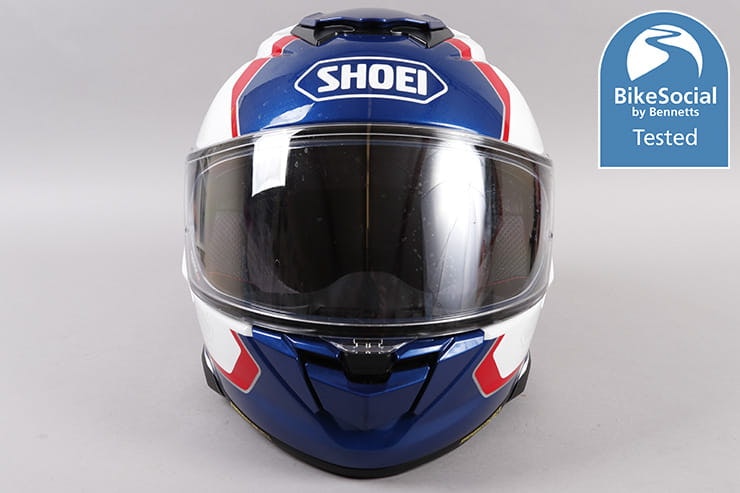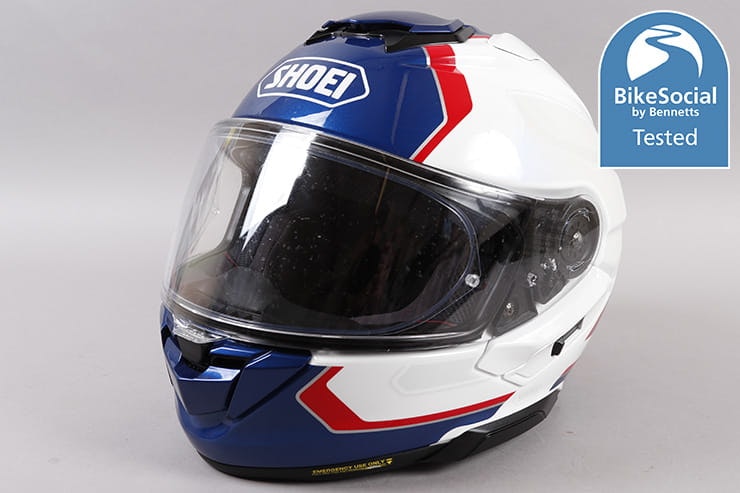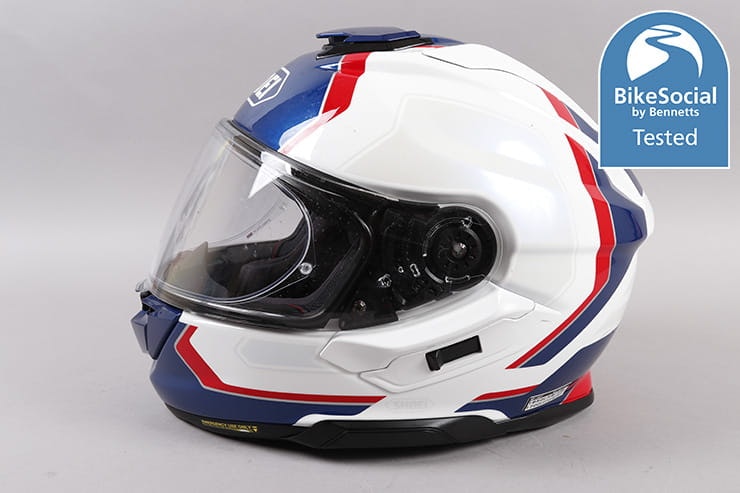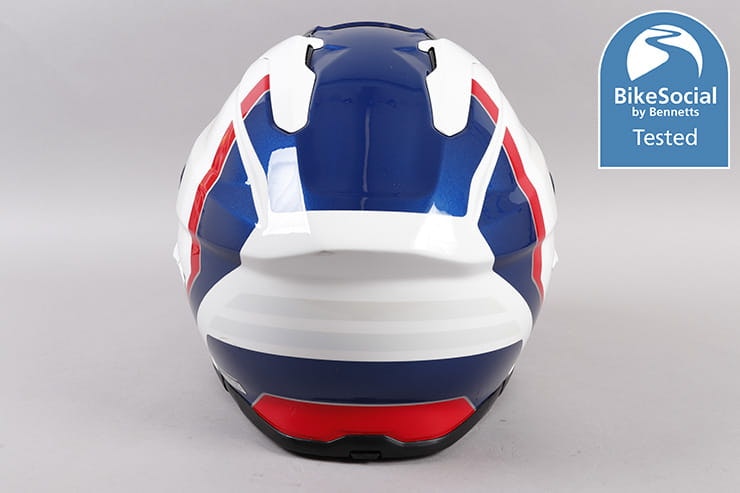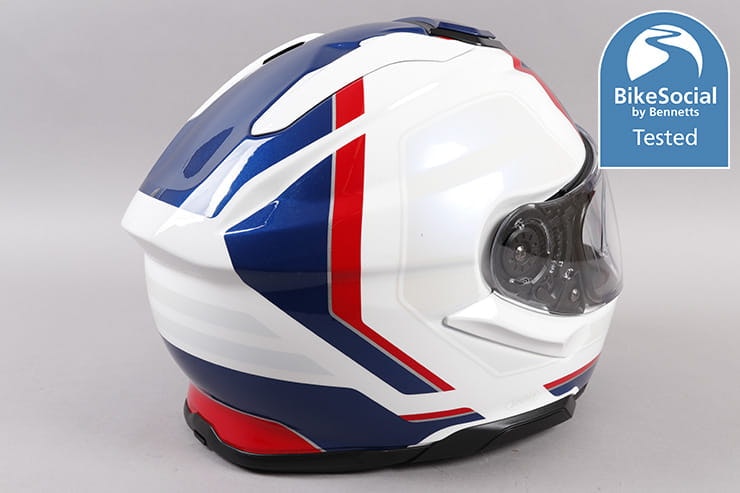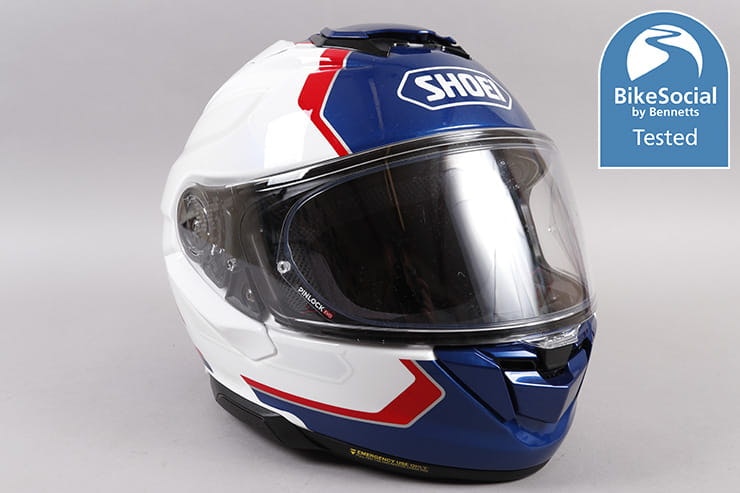Shoei GT-Air 3 review | Arguably the best full-face helmet
By John Milbank
Consumer Editor of Bennetts BikeSocial
30.11.2023
Date reviewed: November 2023 | Tested by: John Milbank | Price: From £529.99 | www.shoeiassured.co.uk
The Shoei GT-Air 3 on review here is a top-of-the-range touring helmet designed predominantly for road riders. With a host of features and premium build-quality it offers a significant challenge to the likes of the Arai Quantic, and could be the choice for many.
I’ve been using it on a 2001 Honda VFR800 and a 2019 BMW R1250GS since it was released in the UK to find out if it’s worth the money…
Great touring fit
Drop-down sun-shield
Good venting
Visor catch can be a little awkward to lock
Peripheral vision is compromised
Some limitations on using your own intercom
Outer shell
The new Shoei GT-Air 3 is an ECE 22.06 helmet, meaning it’s passed a far more stringent set of safety tests than those certified to ECE 22.05, which means it can offer provably greater protection.
The GT-Air 3 also includes a drop-down sun-shield, which for many is the deal-maker. Arai refuses to fit them as it claims the gap between the outer shell and the inner EPS liner reduces potential protection, but this is very hard to assess beyond the minimum requirements of ECE 22.06. While some will argue that there’s no evidence of this being the case, there’s also a counter argument of there being no evidence that it’s not true. I’m working towards measuring this, but until that point you can at least be confident that this helmet meets all the impact requirements of the very latest standard.
No race-focussed helmets use drop-down sun-shields, though this is also down to the fact that adding one increases the thickness of the lid at the front, making it harder to get your head low when tucked behind the screen as it can restrict the view when peering out of the top of the aperture.
The GT-Air 3’s outer shell has a deep gloss and premium feel to it, as you’d expect of a helmet at this price. Retail price is £529.99 (€599 in Europe) in black or white, £549.99 (€629) for plain colours and £649.99 (€729) for graphics like the Realm TC-10 on review here. The graphics have a beautiful metallic sheen to them, with a subtle pearlescent effect in sections at the sides and rear.
The ‘Advanced Integrated Matrix’ glass and organic fibre outer shell comes in three different sizes across the XS-M, L, and XL-2XL ranges and is relatively shapely, with a formed spoiler on the rear and plastic spoilers at the sides said to improve aerodynamics. I’ve certainly had no issues with drag either head-on into the wind, or when turning my head, and there’s been no undue buffeting on the Honda or the BMW.
While not a complaint of the helmet, it’s perhaps worth noting that the rear spoiler can make the GT-Air 3 a little harder to fit into a top box – even my 52 litre Givi Trekker. Most people won’t be riding with the helmet in their luggage, though I would recommend keeping the lid in its bag to avoid this edge getting marked.
Under the interior liner, the EPS has 14 holes that allow air to be drawn out through the exhaust on the top
Weight
On my scales, this medium Shoei GT-Air 3 weighs in at 1,678g, which is a touch more than the Arai Quantic reviewed here. Overall, ECE 22.06-certified helmets seem to be coming in a little heavier on average than many meeting the previous safety standard, but I have never – in more than 27 years of riding – worn a helmet that I’ve found to be too heavy. What really matters is aerodynamics, as a poorly-designed lid can put a lot of strain on your neck this way.
Weight can be a salesperson’s dream and handing you the one they want you to buy with two hands, then waiting until you have that and pass you the next to hold with one hand is a favourite trick to exaggerate the feeling, but unless you have some serious neck problems, I find it hard to believe that weight is an issue.
Anyway, with no noticeable drag, this Shoei isn’t going to be straining anyone’s neck.
Ventilation
The Shoei GT-Air 3 has an open/closed chin vent that’s easy to operate with gloves on and directs air up across the inside of the visor and to your brow. The top vent covers two large ports and is equally easy to operate, with closed, half-open and fully-open positions.
Both work well, though will of course perform differently depending on the size and shape of your bike’s screen, if it has one.
The top vent blows air well across the head, though there are two quite noticeable points where it comes in. Some lids seems to do a great job of providing a smooth flow of air without any cold spots, but this is by no means bad.
There are no exhaust ports at the rear of the GT-Air 3… unusually they’re in the top. Fed by 14 holes in the inner Expanded Polystyrene (EPS) shell, air is drawn out as the wind rushes over the top. This could be a clever move by Shoei, given that heat rises, and while these ports can’t be closed I haven’t noticed it getting particularly cold in use.
I would say though that there’s a fraction more movement of this air noticeable with all the vents closed than some other helmets, though keeping fresh air in the interior is important. Ultimately, with the vents closed and the chin skirt fitted, the Shoei GT-Air 3 isn’t a cold helmet, but if you’re an all-weather commuter you might want to use a neck tube. I don’t use one, but the option’s there.
I’ve ridden in solid rain for over half an hour so far with this helmet, and haven’t noticed any water getting in, but while testing it in the shower I did find some found its way through the exhaust ports and the top vent. This isn’t unique to this helmet, and doesn’t raise any red flags for me, but as with all my reviews, I will keep this updated… I expect to be riding in this lid a lot over the coming months and years.
The chin skirt that’s supplied in the box with the Shoei GT-Air 3 is well worth fitting in the winter months as there’s a fair bit of air movement around the mouth and chin without it. Once in, things are much more still, and it stays in place well when putting the helmet on and taking it back off.
Visor
Shoei visors have always tended to have an effective but smooth ratchet system, and are usually easy to remove and replace. This is no different, despite a new design that sees a locking mechanism at the centre front that’s easy to reach with either hand, so great when stuck in traffic holding the clutch in.
Opening the visor from locked is simple with a gloved thumb, then there’s a useful just-cracked-open position. Beyond that the first ratchet position is a rather high 4cm, followed by four more steps including fully open. It’s okay, but I’d have much preferred a something in-between here, like a 1cm setting.
Despite being smooth, I find the visor stays open at all speeds regardless of its position.
Locking the visor closed does need a certain knack, surprisingly. If I close it with my finger to the left of the catch (with my left hand) it tends to baulk, but if I press it directly down, or from the right it’s fine. The same happens if I press it from the right with my right hand, and it’s simply that the visor’s tabs push in above the catch before slipping over. It’s annoying at first, but within a few miles it’s second-nature to lock it without any problems.
A Pinlock Evo is supplied, which offers the same highest performance as the 120 versions of the anti-fog shield (30 stays fog-free for the shortest time, 70 longer and 120 the longest). Surprisingly, the insert supplied with the GT-Air 3 doesn’t reach as far into the sides of the visor as some others. While not distracting, the edges of the Pinlock and its pins are noticeable in your peripheral vision; something that most other manufacturers have overcome. Overall, peripheral vision is slightly compromised on the GT-Air 3 when compared to the current competition.
The Shoei GT-Air 3 has a drop-down sun-shield that’s easy to operate with a slider on the left of the shell. Unlike far too many other helmets, the shield allows barely any light to leak through its bottom edge thanks to an excellent shape and depth. It also does this without hitting my nose, making it one of the best sun-shields I’ve used. In fact, the only other one as good is in the Neotec 3 reviewed here.
For many riders, a drop-down sun-shield is an essential, and while I do really appreciate the excellent quality of the one fitted in this helmet, I do still prefer a separate dark visor in bright, sunny conditions, or an adventure lid’s peak in the low Autumn/Winter sun as this is far more effective than any shield. However, I can’t deny that the sun-shield on this lid is very well executed, and really handy to pop down when needs be.
Lining
As you’d expect, the GT-Air 3’s interior lining is extremely comfortable, with different thicknesses of cheek pads available for a customised fit from your dealer.
The lining is entirely removable for cleaning and pretty easy to reinstall, with quick release cheek pads to help removal of the helmet in an accident. Only slotting the front of the top section back into the visor aperture is a little fiddly.
If cleaning the interior, it should be done gently by hand. Don’t blame me if you do what I do and pop all the parts in the helmet bag and wash that in the machine on a gentle wash and it goes wrong!
Fastening
The Shoei GT-Air 3 uses a micrometric fastener that’s very easy to use even with gloves on. I prefer these to a double-D as they’re very simple but extremely effective – ideal for a touring lid like this.
This fastener is slightly narrower compared to the one on the outgoing GT-Air II, making it a little more comfortable.
Fit
The most important thing in any helmet is the fit, but it’s of course entirely subjective. There’s no such thing as an ‘Arai head’ or a ‘Shoei head,’ and I find both tend to fit me fine. You must always try any helmet on, regardless of how you’ve found other models – even from the same brand – but this works great for me, including wearing glasses.
The GT-Air 3 is a more relaxed fit than, for instance, the NXR2 reviewed here because it’s much more of a touring helmet, rather than a track one. There’s no need for it to hug your head too tightly, though it’s still comfortably snug and doesn’t move around at speed, which is very important.
Shoei GT-Air 3 noise
No motorcycle helmet is quiet enough to use on a bike over about 40mph, and the biggest issue is the buffeting created by your bike’s fairing and screen, not the wind alone. That also means it’s very hard to say how a lid will work for you on your bike as there are so many variables, including even your height.
I’ve not noticed the Shoei GT-Air 3 to be significantly noisy or quiet in general. It has a slightly different sound to the Arai Quantic, for instance, but it’s got no noticeable issues, except on the GS with the standard screen at its lowest point: at my height, I have to raise the screen a little otherwise it’s noticeably noisy with the chin vent open or the visor cracked.
This will be different for everyone, and I see no obvious reason why it would be more noticeable on this helmet than any other, but something about the combination of airflow on my GS (which also has a large tablet mounted behind the screen), my height and this lid make for increased noise at higher speeds.
For more information on why earplugs are vital with any helmet, and advice on which are the best, click here.
Fitting an intercom to the GT-Air 3
The GT-Air 3 has its own, dedicated SRL 3 intercom system made by Sena, reviewed here, but there's also a Cardo adaptor that clips neatly in place of the SRL 3 buttons cover.
The Cardo Packtalk adaptor is available from UK dealers across the UK, and fits the Shoei Neotec 3, GT-Air 3 and J-Cruise 3 helmets. The two prongs on the side of the adaptor allow a Cardo Packtalk Pro, Edge or Neo bracket to clip easily and securely on (fit it before clipping the adaptor into the lid). This does mean that you can't use it with devices like the excellent Spirit HD or the older (but still good) Cardo Freecom range, but I tried fitting an intercom without the adaptor to find out how others – including devices from Sena, Interphone and Midland for instance – could be attached (see below).
While the Cardo adaptor clicks very easily into the side of the helmet, the way it engages with curved slots means it can't just pull off as you use or remove the intercom – you have to pull back the tab on the adaptor to release it.
While having a Packtalk isn't as streamlined as the SRL 3 of course, it's a great solution and well worth the £19.99 price tag. Cardo also made an adaptor for the previous generation of these Shoeis, so if the design does change in future models (hopefully the GT-Air 4 will use the same SRL 3 and it won't need a new version), then it seems likely Cardo will continue to provide a way of attaching them.
If you have the older SRL 2 intercom, it can be fitted using an adaptor from your Shoei stockist.
If you're not using the SRL 3 or the Cardo Packtalk adaptor, you should be able to fit pretty much amy intercom to the GT-Air 3 with a little care.
I found a Cardo Packtalk will fit just below and to the rear of the sun-shield slider, which is a little further back than I’d like but not too bad. The speakers tuck in, but it’s a tight fit so check yours have a diameter of less than or equal to 44mm. The base of the Cardo JBL speakers fit this, but while the tops are larger, I still found they fit in okay without pressing against my ears.
Three alternatives to the Shoei GT-Air 3
There are hundreds of options when it comes to full-face helmets, and plenty a lot cheaper. While new models will all meet the same safety standard, paying more can give increased comfort, ventilation and visor quality for a start. What matters most is that a helmet fits you properly, but here three other premium models to consider…
Arai Quantic | From £499.99. The first ECE 22.06 helmet on the market, this has excellent ventilation and great comfort. But it doesn’t have a drop-down sun-shield, so if that’s vital to you, you’ll need to look elsewhere. A very good helmet though, as you’ll see from our Arai Quantic review here.
HJC RPHA 71| From £399.99. A great helmet that competes with the GT-Air 3 but is a fair bit cheaper. Definitely worth checking out after you’ve read our full review, which is coming very soon.
Schuberth S3 | From £429.99. We’ve not reviewed this Schuberth but it’s another premium touring full-face that’s worth considering.
These are just three of many alternatives – you can find all the motorcycle helmets we’ve tested here and be sure to regularly check for the discounts available through Bikesocial membership.
Shoei GT-Air 3 review: Verdict
The Shoei GT-Air 3 is one of the most expensive in its class, but it’s got the build-quality and features to back that up. If you’re not bothered about a drop-down sun-shield, and especially if you want to easily fit your own intercom system it’s worth looking more closely at the competition, but overall this is an excellent helmet that works very hard to justify the cost that you’ll be investing over a good five years or so of use. Definitely one to try if you’re in the market for a premium touring full-face helmet.
If you’d like to chat about this article or anything else biking related, join us and thousands of other riders at the Bennetts BikeSocial Facebook page.
Best sport-touring helmet: Arai Quantic vs Shoei GT-Air 3 vs HJC RPHA 71 vs Shark Spartan GT
Four top-of-the-range full-face sport-touring helmets reviewed: Arai Quantic vs Shoei GT-Air 3 vs HJC RPHA 71 vs Shark Spartan GT Pro Carbon. They're all premium ECE 22.06 helmets, and in this video, we'll cover everything you need to know before deciding which is best for you.
